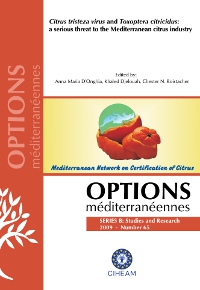| Article précédent | p. 125-128 | Article suivant |
Current status of Citrus tristeza virus in Lebanon
This paper summarizes the field status of citrus tristeza virus (CTV) in Lebanon. Based on the first virus survey conducted in citrus commercial groves and nurseries in autumn of 1996, CTV was reported officially in Lebanon with an overall infection rate of 1.43 percent. Another survey was undertaken between 1998 and 2000 in Mount Lebanon in addition to the adoption of four experimental plots in the South to assess the CTV incidence. CTV was only detected in the South with an increased infection rate from 1.2 to 3.8 percent in plot II, and from 2 to 5 percent in plot III whereas the CTV infection rate in plot I was stable (1.1 percent) with no concomitant infection in plot IV. The vectors Aphis gossypii and Aphis citricola were identified whereas Toxoptera citricidus, the most efficient CTV vector, was not encountered. With the aim to establishing a citrus mother block for the production of plant certified material, another field survey was carried out between 2003 and 2004 in the South and North of Lebanon close to LARI stations and CTV was found only in the South. Interestingly, no evidence of the disease was observed in the CTV-infected trees as ascertained by repeated observations in the field. Further work and preventive measures should be applied to secure the future of the citrus industry in Lebanon.
Cette étude résume la situation du virus de la Tristeza des agrumes (CTV) au Liban. Sur la base d'une première prospection menée en automne 1996 dans les vergers commerciaux et pépinières d'agrumes, le CTV a été signalé officiellement au Liban avec un pourcentage d'infection égal à 1.43 pour cent. Une autre enquête a été réalisée entre 1998 et 2000 au Mont Liban, ainsi que dans quatre parcelles expérimentales au Sud afin d'estimer l'incidence du CTV. Le virus a été détecté uniquement au Sud où le pourcentage d'infection a évolué durant les trois années d'expérimentation en passant de 1,2 à 3,8 pour cent dans la parcelle II, et de 2 à 5 pour cent dans la parcelle III, tandis que le pourcentage d'infection dans la parcelle I est resté stable (1,1 pour cent). Aucune infection n'a été signalée dans la parcelle IV. Les vecteurs Aphis gossypii et Aphis citricola ont été identifiés, tandis que Toxoptera citricidus n'a pas été retrouvé. Dans le but d'établir une parcelle de pieds mères destinée à la production de matériel certifié, une autre prospection a été effectuée aux alentours des stations de l'IRAL au Sud et au Nord du pays. Le virus a été trouvé seulement au Sud. Par ailleurs, les symptômes typiques n'ont pas été observés chez les arbres infectés. Des mesures préventives sont à appliquer dans l'avenir afin de préserver l'agrumiculture libanaise.
- [ Afficher ]
- [ Télécharger ]
- [ Exporter la citation ]
Vous pouvez télécharger la citation au format :
- [ Imprimer ]
-
Mots-clés
AGRUME, APHIDIDAE, CITRUS, CLOSTEROVIRUS TRISTEZA DU CITRUS, HISTOIRE, LIBAN, VECTEUR DE MALADIECiter cet article
Choueiri E. Current status of Citrus tristeza virus in Lebanon. In : D'Onghia A.M. (ed.), Djelouah K. (ed.), Roistacher C.N. (ed.). Citrus tristeza virus and Toxoptera citricidus: a serious threat to the Mediterranean citrus industry. Bari : CIHEAM, 2009. p. 125-128. (Options Méditerranéennes : Série B. Etudes et Recherches; n. 65). http://om.ciheam.org/om/pdf/b65/00801402.pdf



